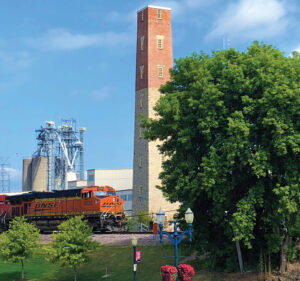Lead mining and smelting attracted more 19th century settlers to the Upper Mississippi River Valley than fur trading or farming. But long before the first white man paddled down the Mississippi River, Native Americans in what would become Illinois, Wisconsin, and Iowa gouged lead from rich deposits to use in their burial rituals and as body paint.
French explorers first reported seeing lead deposits in Illinois in the mid-1600s, although lead mining didn’t really catch on in the area until the early 1800s. Galena, in northwest Illinois, was the site of the first U.S. mineral rush. Settlers began arriving in 1821. Seven years later, more than 10,000 made their homes in Galena’s Fever River Valley, most of them lead miners. By 1845, Galena and surrounding Jo Daviess County produced 80% of the country’s lead.
By 1829, more than 4,000 miners dug and smelted lead ore in southwest Wisconsin, producing 13 million pounds annually. Mining towns like Mineral Point, Hardscrabble (now Hazel Green), Black Jack, Lead Mine, New Diggings, Snake Digs, and Irish Diggings (now Shullsburg) quickly grew around Wisconsin lead mines.
When Julien Dubuque arrived in what would become Iowa in 1788, he found Meskwaki women and old men mining lead near Catfish Creek, south of present day Dubuque. After Dubuque persuaded the natives to grant him mining rights, an agreement was signed upriver at Prairie du Chien on September 22, 1788. Dubuque wanted formal recognition of his agreement with the Indians, and so he appealed to the Spanish Governor-General who granted Dubuque the land known as the “Mines of Spain.”
Lead mining in Iowa became big business in the spring of 1833 when the area officially opened for settlement after the ratification of the Black Hawk War Treaty. Lead from the mines was smelted into blocks or “pigs” and sent south on Mississippi riverboats to St. Louis where it was manufactured into pewter, pipes, weights, paint, and ammunition. Early Dubuque miner and historian Lucius H. Langworthy claimed the amount of lead sent downriver from the Dubuque mining district between 1833 and 1856 ranged from 40 to 60 million pounds each year.
Although there was plenty of lead available to make ammunition for the U.S. military, until 1807 all lead shot was imported from Europe. In 1782, English plumber William Watts perfected a new technique for manufacturing round shot by dropping molten lead through sieves into pools of water in specially constructed shot towers.
Thomas Jefferson’s 1807 Embargo Act ended all international trade to and from U.S. ports, and shot towers began to spring up in the U.S. The first two shot towers were built in Virginia and Philadelphia to produce shot for the War of 1812. Others soon followed in New York, Maryland, Connecticut, Ohio, St. Louis, Boston, San Francisco, and in little lead mining towns scattered along the Upper Mississippi River Valley.

Today, only a few intact shot towers remain in the country, and most of them are in the East. However, two still stand along the Upper Mississippi River Valley – a reconstructed tower near Spring Green, Wisconsin, and the original 1856 shot tower in Dubuque.
Dubuque’s 150-foot, tapered stone and brick shot tower was built at the foot of the Mississippi River levee in 1856 by local gunsmith George Rogers at a cost of $7000. A steam engine ran a windlass that hoisted lead pigs up to the furnace on the top floor of the tower where they were melted, dropped through sieves, and allowed to harden in a tank of water at ground level. Some 12,000 pounds of shot were polished, sorted, and bagged daily.
Roger’s shot challenged the monopoly of St. Louis shot producers Chadbourne & Forster. The Missouri company slashed their prices in retaliation, selling shot well below cost and eventually driving Rogers out of business.
Ownership of the Dubuque Shot Tower passed through several hands until Julius Graves bought it in March 1860 for just $1200. By July 1862, Graves admitted defeat and sold the tower to Chadbourne & Forster for $3000. As part of the sale agreement, Graves promised not to produce shot from another tower. Graves kept his promise, but he and others continued to make shot by dropping lead down a mine shaft west of the city.
The St. Louis company boarded up the Dubuque tower, and it stood abandoned until the Standard Lumber Co bought it in 1881 to use as a watch tower. A fire started by an arsonist in May 1911 destroyed the lumber yard and the wooden interior of the shot tower.
A local association of concerned citizens purchased the charred remains of the shot tower in 1915 and transferred title to the City of Dubuque the following year. The structure remained a ruined shell for decades until a 1960 renovation project tuck-pointed the stone and brick, installed and repaired windows, and excavated and fenced the base. The Dubuque Shot Tower was listed on the National Register of Historic Places in 1976.
Mayor Roy Buol declared 2006 the “Year of the Shot Tower” in recognition of the structure’s sesquicentennial. A $600,000 rehabilitation project funded by federal and state grants and private donors was completed in September 2010. An initial archeological survey inside the tower uncovered the original well where shot was once cooled. Restoration of the tower included tuckpointing and masonry repairs as well as a new roof, door, and windows.
Today, Dubuque’s historic shot tower stands north of the city’s Riverwalk, at the foot of Commercial Street, a silent testimony to past years when lead was king in Dubuque.
This article is part of the Shades of Dubuque series, sponsored by Trappist Caskets, hand-made and blessed by the monks at New Melleray Abbey.





Comment here